Text
IGB120 - Assignment 2 Final
Here's an update on my progress for Assignment 2: I've begun working on my One Page, which contains more detailed information about my game concept. Currently, I'm using sprites and images sourced online to illustrate what players can expect in the final prototype. If my idea is chosen by my teammates, we'll collaborate to create our own unique sprites and animations, pooling our creativity to enhance the game's aesthetics.
Here is the final version of my one-page design:

Here are some highlighted points:
Description:
The game revolves around controlling Rocky the raccoon, who explores stages to collect scattered litter.
After clearing all litter, a key appears for the player to collect, unlocking the door to the next stage.
Obstacles and enemies hinder the player's progress, and Rocky can only evade enemies by hiding in trash cans.
The game features multiple stages, with increasing difficulty as players advance.
Game Level Design:
Players navigate each stage by parkouring to reach litter collection points.
The game transitions between city and forest settings to depict Rocky's journey.
This is my completed one-page design. I hope to find teammates who share an interest in creating a platformer game similar to this concept.
0 notes
Text
IGB120 - Assignment 2 Progression
Here's my current progress for Assignment 2 of IGB120. My game concept is a platformer called "Litter Looter," where players control a raccoon named Rocky on a mission to collect trash in both the city and the forest. Along the way, Rocky faces obstacles like enemies guarding the litter. Being a timid raccoon, Rocky must hide in nearby trash cans to avoid detection until it's safe to continue collecting litter.
Here's my completed 30-second timelapse drawing for the One Sheet section. Next, I'll use Photoshop to add and tweak the text, ensuring all the necessary information is included for my one-sheet submission.

This artwork was created on my iPad using the Procreate software. I drew everything on this canvas myself.
After creating the art piece, I imported it into Photoshop to include all the required information for the Assignment 2 submission. Here is the finished and completed one sheet for my submission:

0 notes
Text
GDevelop - Racer Development
My racer game draws inspiration from popular mobile titles like "Subway Surfers" and "Temple Run," which I spent countless hours playing. I'm aiming to capture the same addictive and straightforward gameplay in my own racer game prototype.
Here's an update on the progress of my racer game:
Intro
In the game introduction, there's a straightforward animation where the title and game instructions gradually descend from the top while the player's car enters the scene from the bottom. This preview offers players a glimpse of the game's visuals and mechanics even before they start playing.
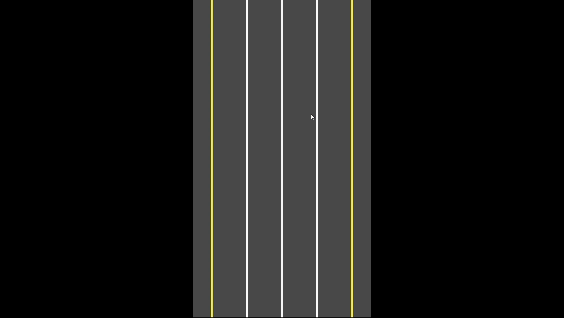
In the introduction, we've included several crucial elements:
An engaging intro theme song
The player car's animated entrance into the frame
Animated presentation of the game title and instructions
Trees spawning along the road's edges to set the game's ambiance
Transitioning to the game scene by pressing the space key, moving the title, instructions, and player car off-screen
This is the layout of the event sheet for the intro scene:

Game Scene
The game scene closely resembles the tutorial from the workshop but with a small twist. I've introduced coins and a high score feature to incentivize players to compete and strive for better scores and to collect as many coins as possible.
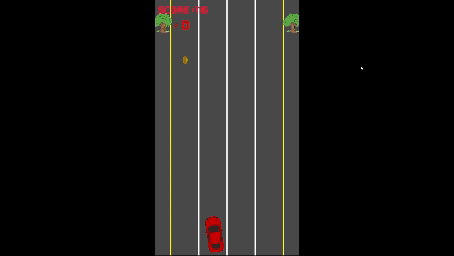
The player's score is based on their survival time in the game; the longer they last, the higher their score. To add an extra challenge and temptation, I've placed coins along the road, including some in hard-to-reach spots, to entice players to take risks and test their skills.
Here is the list of events required to make this game scene possible:
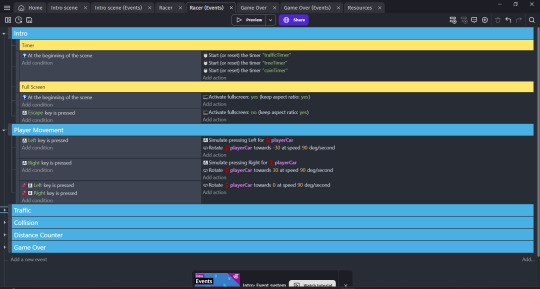
Beginning of the Scene & Player's Controls
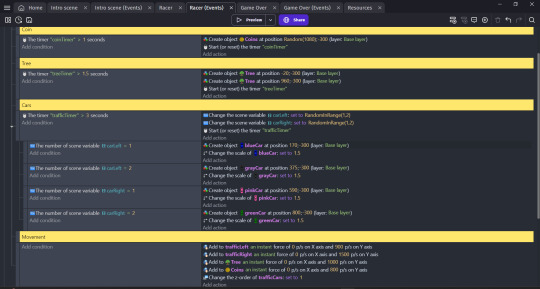
Traffic Spawning & Movement of Traffic's
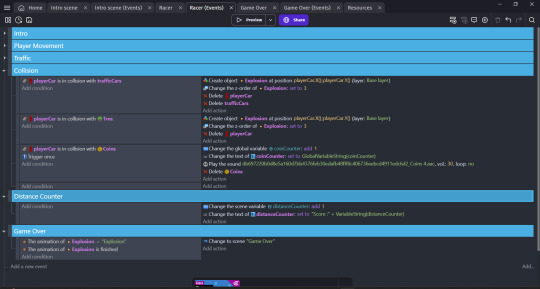
Collision of Tree, Cars, and Coins
Distance Counter for the score
Transition to Game Over scene
Game Over
Due to time constraints, the game over scene is quite basic. It simply displays text announcing the game over and prompts the player to reset by pressing "R". Additionally, it shows the total number of coins collected before the player lost the game.
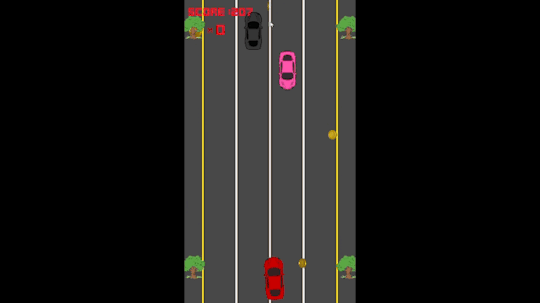
Upon collision with the game over scene, a theme song will play, signaling to the player that they have lost. However, the upbeat tone of the song aims to encourage the player to try again and strive for a better score in their next attempt.
Conclusion:
In conclusion, while I feel there's still ample room for improvement, time constraints limited the full development of my game to my desired vision. However, I plan to present it in the workshop for playtesting among my classmates to gather their feedback and insights. As emphasized in the Game Design Workshop readings, playtesting is crucial for refining games, as it provides valuable perspectives and identifies areas for enhancement. This iterative process ensures that the final product is more polished and enjoyable for players. (Fullerton, 2018).
References:
Fullerton, T. (2018). Game design workshop: A playcentric approach to creating innovative games, fourth edition. CRC Press LLC.
0 notes
Text
GDevelop - Asteroid Post Mortem
In this stage of developing my Asteroid game "Meteor Mayhem," my main goal was to improve various aspects based on player feedback. One key area I worked on was the game's difficulty level. Feedback from both players, who happened to be competitive gamers, highlighted that the game was too easy. In response, I adjusted the difficulty to make enemies more challenging and engaging in combat.
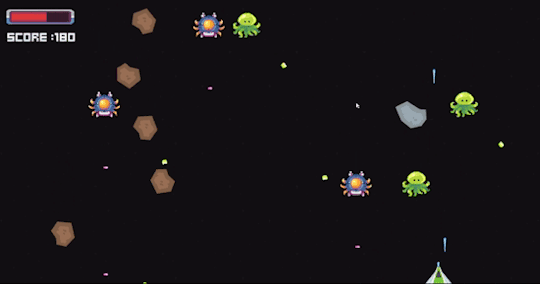
One Thing I Would Change To Improve My Process:
Now, I've realized I need to make my game more balanced for all players. I can do this by adding different difficulty levels. As players advance, the game gets harder. I learned this in the 'Fullerton - Game Design Workshop' book. So, I'll use this idea to make my game better. (Fullerton,2018)
One Thing I Would Change About The Design:
If I could alter something about my design, it would be the game's background. Currently, it's plain and lacks excitement. Since the game is set in space, it would enhance the experience to have an animated GIF or video as the background. If I find the time, I'll definitely work on improving the background design.
One Thing I Would Change About The Prototype:
I'd enhance my prototype by adding more variety to the gameplay instead of just having a straightforward battle with enemies and asteroids. It would be more engaging to introduce different events that keep players on their toes, not knowing what challenges they'll face next. Right now, the game feels dull with repetitive actions and lacks sufficient content.
References:
Fullerton, T. (2018). Game design workshop: A playcentric approach to creating innovative games, fourth edition. CRC Press LLC.
0 notes
Text
GDevelop - Elevator Pitch for Racer Game
In the prototype of my Racer game, I'm crafting an engaging experience that blends simplicity with addictiveness, demanding fast thinking and decisive actions from players. Here's an Elevator Pitch outlining all the key aspects of my Racer Game prototype:
Name of Game:
Dash 'n Dodge
Description of Game:
Dash n' Dodge is an exciting top-down racing game where players take control of a speedy car on a mission to zoom ahead while avoiding obstacles. The goal? Race as far as you can while grabbing coins and speed boosters to push your limits and score big!
Genre of Game:
Survival/Racing
Target Audience:
Ages 7+
Mechanics of Game:
Boost: "Space" key
Movement: Arrow keys
Settings of the Game:
In the world of Dash n' Dodge, you're racing along the endless highway, dodging traffic and grabbing power-ups to speed ahead and rack up your score.
Elevator Pitch:
In Dash n' Dodge, you'll navigate an endless highway filled with oncoming traffic, a renowned racers' proving ground for speed demons. How far can you push your limits? How high can you climb the leaderboard? It's a test of skill as you aim for the ultimate glory!
Concept and Reference:
This game draws inspiration from popular mobile titles like "Subway Surfers" and "Temple Run," where players aim to outlast their previous best by running as far as they can on the course provided.
Subway Surfers
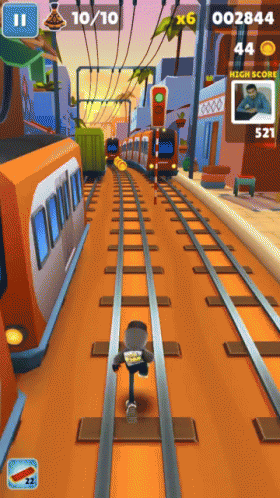
Source: https://www.pinterest.com.au/pin/797559415272934153/
Temple Run

Source: https://playtemplerun2online.wordpress.com/2014/08/04/feel-double-thrill-adventure-with-play-temple-run-2-online/
Conclusion:
To sum up, Dash n' Dodge takes inspiration from classics like 'Subway Surfers' and 'Temple Run,' adding its own unique twist. The aim is to evoke nostalgic memories of these beloved games while delivering an exciting experience with Dash n' Dodge.
1 note
·
View note
Text
Weekly Readings - Game Design Workshop - Chapter 6
These are some key points I've summed up after reading Chapter 6 of Game Design Workshop.
Conceptualization in Game Design
Game design begins with conceptualization, a process where ideas are born and eventually transformed into interactive experiences. Understanding this process is vital for game developers aiming to craft engaging and memorable games. In this blog post, we'll explore the significance of conceptualization in game design, offering practical insights into various stages, from generating ideas to refining them into playable games.
Where do Ideas come from?
Game ideas can come from many places, like personal stories, books, movies, nature, tech, and culture. Game makers can get inspired by what's around them and use it to create cool and interesting games.
Brainstorming: Why and How Should We Brainstorm?
Brainstorming is super important for coming up with lots of ideas fast. It works best when everyone's working together in a supportive and open-minded way. During brainstorming, people can think of new and different ideas, and help each other build on them. Techniques like mind maps, word games, and acting out scenarios can make brainstorming even more effective and help come up with awesome ideas.
Editing and Refining: After the Brainstorming
After brainstorming, it's time to narrow down the ideas and pick the best ones. This means carefully looking at each idea and deciding if it fits the game's vision, if it's possible to do with the time and money available, and if players will like it. By refining ideas over and over, game designers can make sure they're only working on the best ones.
Turning Ideas into Games:
After finalizing a good game idea, the next step is to make it into a game people can play. This means figuring out how the game works, what the story is, how it looks, and what sounds are in it to make it all fit together. Prototyping lets developers try out their ideas, tweak how the game plays, and find ways to make it better before making the final version.
Ideas vs Design:
Ideas spark the start of game concepts, but it's game design that makes them real. Game design covers lots of different things like how the game plays, what the levels are like, the story, how it looks, sounds, and how players interact with it. When game developers get how ideas and design work together, they can make awesome games that players love.
Conclusions:
Conceptualization is like the foundation of game design, leading developers from having ideas to making complete games. When game developers are good at conceptualizing, they can come up with all sorts of cool and fun ideas for games. Whether they get inspired by everyday stuff or let their imagination run wild, turning an idea into a game is super exciting and full of possibilities.
References:
Fullerton, T. (2018). Game design workshop : A playcentric approach to creating innovative games, fourth edition. CRC Press LLC.
0 notes
Text
GDevelop - Asteroid Playtesting
During this week's workshop, we were given the time to refine our asteroid game to be ready for playtesting by our peers. Here are some of their valuable feedback that I have taken note of using the basic template that was provided for us during the lesson.
Player 1

What works?
Movement: "The movement mechanics are relatively simple and generic which makes the game easy to play."
Difficulty: "The game felt pretty balanced."
Flow: "I like the flow of the game."
Animation: "I appreciate the animation work you've done for the intro and game-over scene. Really adds the feels to the game."
Things to improve on?
"Make the special enemies like the beetle and chutulu able to fight back"
"Perhaps changing the speed of the special enemies to something different rather than both the same speed would prove slightly more challenging."
New Ideas?
"Maybe a boss fight would be interesting."
"I'm a competitive player so perhaps increase the difficulty by spawning more enemies or obstacles."
What do you think was the most exciting or fun moment for you as you played?
"Dodging of the meteorites because I rather shoot the enemies for more points."
Player 2

What works?
Animation: "I love the animation done for the intro, it's really cool."
Enemies: "I love how killing the enemies gives you more points than the meteorite. Kinda gives you the motivation to prioritize the higher points instead."
Bullet: "The fire rate makes sense since there isn't much time to shoot the higher health enemies therefore the faster we press the more we shoot is needed."
Things to improve?
Difficulty: "Making the enemies like Chutulu and Beetle shoot back would be better, else it's pretty much just a spamming shooting game."
New Ideas?
"Make the meteorite shattered into multiple pieces so that if it collides with the player, the player will still take damage. That will be intense."
What do you think was the most exciting or fun moment for you as you played?
"Currently none at the moment but if the game difficulty increases, it'll definitely be more fun and exciting."
Conclusion
Unfortunately, I could only manage to have two players playtest my asteroid game, as I spent a lot of time asking them questions after their playtest.
In summary, both players mentioned that the game's difficulty should be ramped up to make it more competitive, as they found it lacking in challenge. Taking their valuable feedback into account, I will reflect on it and make further improvements to my game.
1 note
·
View note
Text
GDevelop - Asteroid Development #1
The goal of the Asteroid game I'm working on is to capture the essence of the classic 'Space Invaders' game from the 1970s. While it shares similarities with Space Invaders, such as dodging meteorites, shooting down enemy spacecraft, and dealing with obstacles, it brings a fresh twist to the nostalgic gaming experience.
Here's how my asteroid game is coming along:
Intro
The introduction to my game is designed with subtle animations to build excitement and give players a taste of what the game is all about before they even start playing.

In the intro, we've set up a few key elements:
A catchy intro theme song to set the mood.
An animation of the player ship entering the frame, adds a dynamic touch.
Floating animations of the game title and descriptive text to grab attention.
Meteorites spawn in the background, giving players a taste of the game's main challenge.
Pressing any key will propel the player ship forward into the portal, seamlessly transitioning into the game scene.
This is what the event sheet for the intro scene looked like:
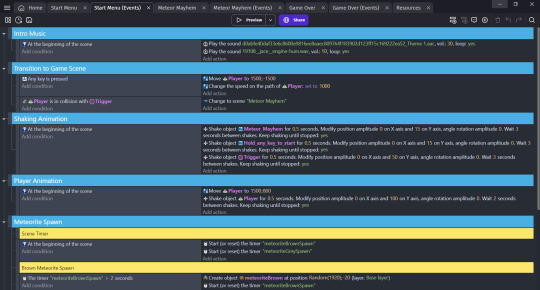
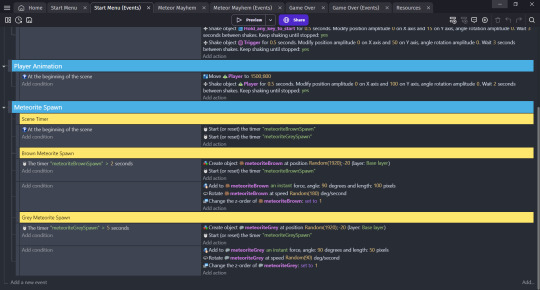
Game Scene
The game scene follows the typical setup of a space shooter game. It features straightforward movement mechanics, and the objective is to destroy as many enemies and meteorites as possible before running out of life.
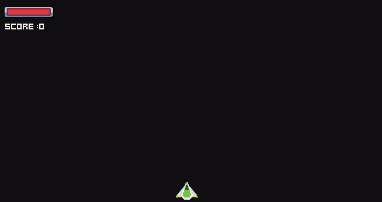
Each bullet does a total of 10 damage and every kind of object has its own health point. Here is a breakdown of all the health of the objects:
Player: 25 hp
Brown Meteorite: 10 hp
Grey Meteorite: Unbreakable
Chutulu: 100 hp
Beetle: 50 hp
Here is a breakdown of all the scores obtainable after destroying it
Brown Meteorite: 10 points
Grey Meteorite: Unbreakable
Chutulu: 100 points
Beetle: 50 points
Here's the list of events required to make this game scene possible:
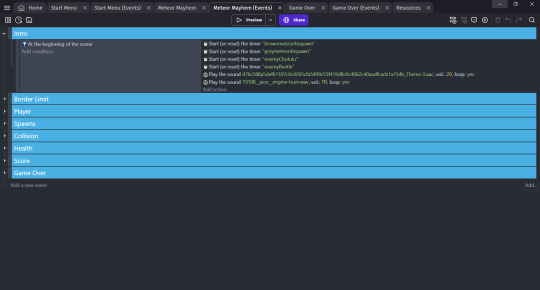
Beginning of the Scene
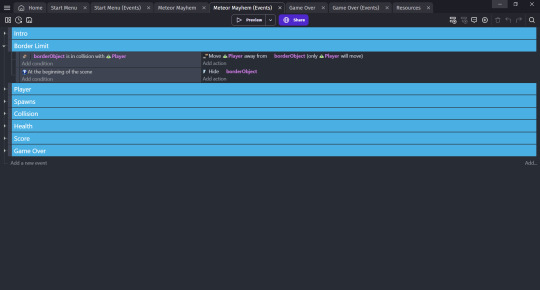
Border Limits: to prevent players from going out of the camera frame
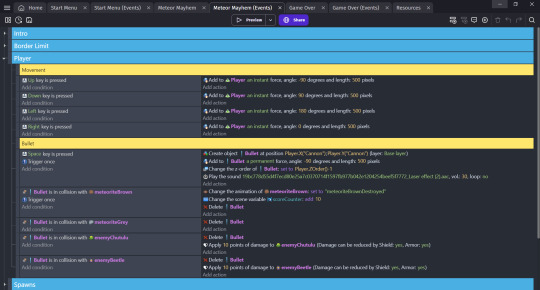
Player: Controls and Bullet
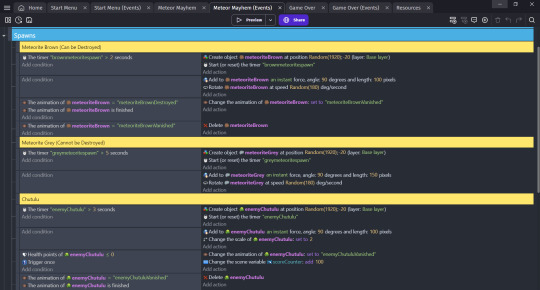

Spawns: Meteorites and Enemies spawn
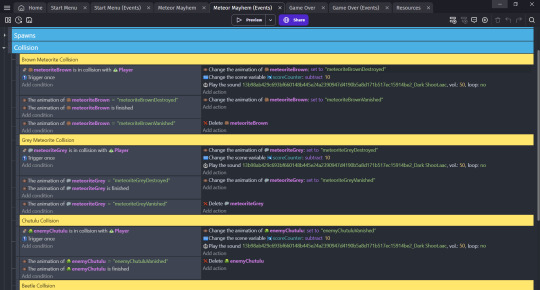
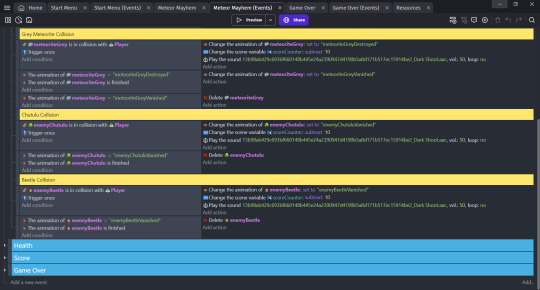
Collision: Including points system
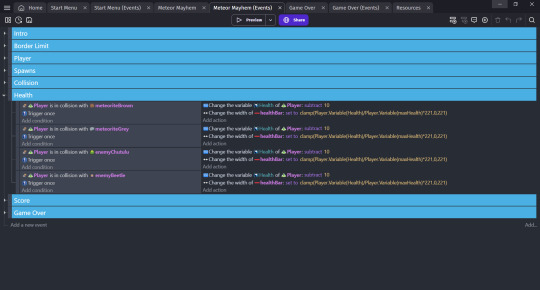
Health: How much damage the player will take upon collision of the meteorite or enemies
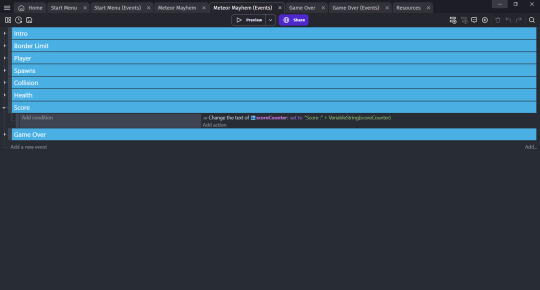
Score
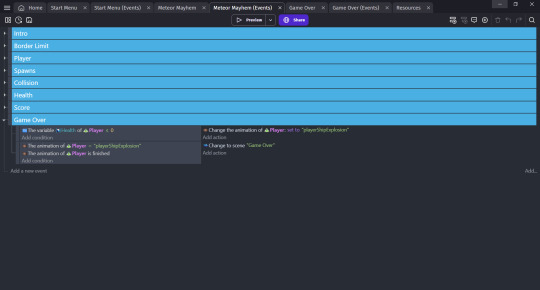
Game Over: Transition to game over scene when health reaches 0
Game Over
The 'Game Over' scene mirrors the intro scene, with the "Game Over" text transitioning into the center of the frame. Additionally, instructions prompt the player to return to the main menu if they wish to restart the game.
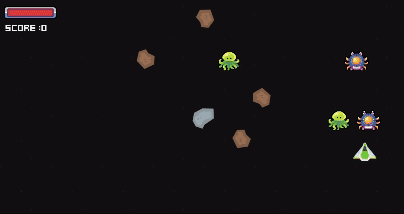
After being defeated, a themed song plays, setting the tone for the moment. Meanwhile, meteorites continue to spawn in the background, encouraging players to come back and destroy them. Players can press the 'Space' key to return to the main menu and try again.
Conclusion
In summary, I believe there's ample room for improvement in my game, and my plan is to bring it to the workshop and have my classmates playtest it. Their feedback will be invaluable in making necessary changes. As emphasized in the Game Design Workshop readings, creating a game without player feedback is futile, as the ultimate goal is to create a game that players will enjoy. This has inspired me to share my game with my friends and classmates to gather insights and continue refining it based on their preferences (Fullerton, 2018).
References:
Fullerton, T. (2018). Game design workshop : A playcentric approach to creating innovative games, fourth edition. CRC Press LLC.
0 notes
Text
GDevelop - Elevator Pitch for Asteroid Game
For my prototype of the Asteroid game, I'm developing a solo space shooter experience. This post serves as an Elevator Pitch for my Asteroid Game, providing all the details of my prototype space adventure below.
Name of Game:
Meteor Mayhem
Description of Game:
In 'Meteor Mayhem,' brace yourself for an epic journey through space! Navigate asteroid fields, engage in thrilling battles, and dodge meteors to emerge victorious. It's a pulse-pounding adventure that'll keep you on the edge of your seat!
Genre of the Game:
Action/Survival
Target Audience:
Ages 7+
Mechanics of the Game:
Movement: Arrow keys and Spacebar
Setting of the Game:
In this space-themed game, your battleship faces off against waves of enemy ships while dodging or destroying incoming meteors. Each hit from a meteor damages your battleship, reducing its health. Earn points by destroying enemy ships to survive as long as you can.
Elevator Pitch:
'In Meteor Mayhem, players take on the role of piloting a battleship, tasked with surviving waves of enemy battleships and incoming asteroids for as long as possible. Accumulate points by destroying enemies, but be prepared to swiftly dodge enemy bullets and asteroids using fast reflexes. How long can you withstand the onslaught before succumbing to defeat?'
Concept Art:
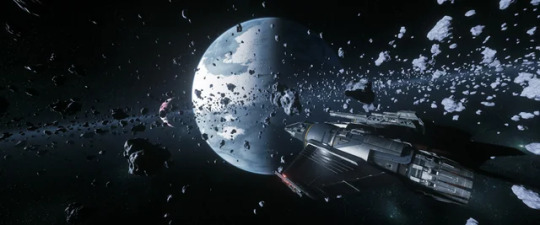
Source: https://www.reddit.com/r/starcitizen/comments/16sd1hk/love_asteroid_feilds_after_battle/?rdt=51858
This will be the planning for my upcoming asteroid game. Please do leave a comment in any post to give any feedback as all feedback is valuable to help me better develop my game!
0 notes
Text
GDevelop - Platform Game Postmortem
During this phase of development, my primary focus was on refining every aspect of the game. This involved several tasks, such as adjusting the appearance of the sprites to match the game's theme and creating gameplay mechanics that require players to practice before progressing. These refinements are essential to ensure that the game is enjoyable for players of all skill levels, whether they're beginners or seasoned gamers. By paying attention to these details, I aim to deliver a more immersive and satisfying gaming experience.
One Thing I Would Change To Improve My Process:
If I was to improve a part of my process. It would be to do more research into world-building. Just like the readings I've learned in Chapter 4 of the 'Fullerton - Game Design Workshop', I'll add different and cool-looking environments to the game. This will make it more interesting and fun for players. I'll try out different themes and settings to give players a mix of experiences (Fullerton, 2018)
One Thing I Would Change About The Design:
Looking back, one thing I'd change about the design is the background design. While the sci-fi environment was cool, I realized that having the same background for every level was a missed opportunity. In the future, I'd love to incorporate more diverse and aesthetic backgrounds to enhance the overall experience.
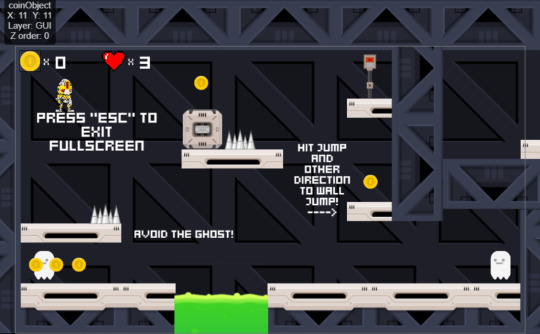
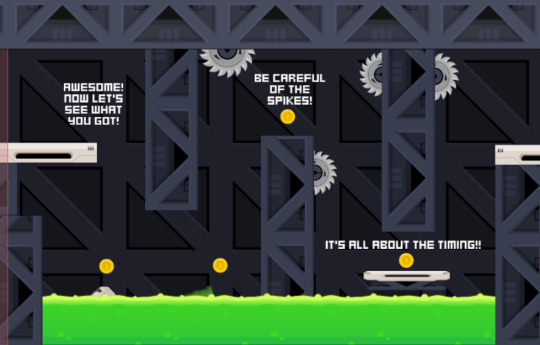
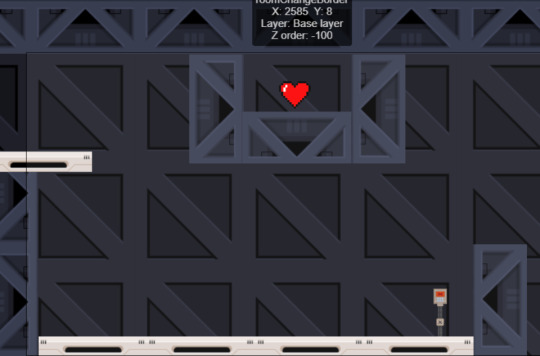
One Thing I Would Change To The Prototype:
If I were to make a change to the prototype, I'd focus on improving the game's look and feel. Beyond that, I'd work on adding more levels and content to keep players engaged. Overall, I'm happy with how the game is shaping up, and I'm cautious about making any big changes that might veer too far from my initial planings.
References: - Fullerton, T. (2018). Game design workshop: A playcentric approach to creating innovative games, fourth edition. CRC Press LLC.
0 notes
Text
Weekly Readings - Game Design Workshop - Chapter 10
Here are some key points I've summed up after reading Chapter 10 of Game Design Workshop.
Functionality, Completeness, and Balance
In game design, making a game that sucks players in and keeps them having fun relies on three important things: making sure it works well (functionality), finishing it completely(completeness), and balancing everything just right(balance). These factors are super important for making sure players have a good time and feel like the game is fair. In this blog post, we'll talk about what each of these things means and how they make a game awesome.
Game testing:
Before getting into all the details about how well the game works, if it's finished, and if everything's balanced, you need to know what you're testing. The first version of your game is like the starting point for these tests. It helps you see what needs to get better and what areas you need to work on.
What makes a game functional?
A functional game is one where everything works smoothly. From simple controls to more complicated stuff, without any big problems or glitches. It means players can use menus, interact with things, and keep playing without the game crashing or messing up.
Internal completeness of the game:
Internal completeness means making sure everything in the game fits together well. This includes how the game plays, the story, and how it looks and sounds. Testing for internal completeness means finding and fixing any problems or things that don't make sense, so players stay immersed in the game world.
Game balancing:
Game balance is super important for making sure players have fun and the game feels fair. This means making sure challenges match up with how skilled the player is, and that the rewards are worth the effort. It also means not letting one strategy or character be way better than everything else. Balancing involves things like making enemies the right level of toughness, making sure there's enough stuff to collect, and giving different characters different abilities to keep the game interesting.
Techniques for balancing the game:
Making sure a game is balanced needs a mix of testing, looking at data, and making changes bit by bit. Stuff like A/B testing, asking players for feedback, and checking how people play the game can help find what needs fixing. Also, breaking the game down into smaller parts can make it easier to adjust things and get the balance just right.
Conclusions:
In conclusion, getting the hang of functionality, completeness, and balance is key to making awesome games. By carefully testing and polishing every part of the game, developers can make sure players have a smooth, fun, and fair time playing. Whether it's trying out the game lots, making changes as they go, or listening to what players say, making great games is all about keeping the creativity flowing and giving players something they'll never forget.
References:
Fullerton, T. (2018). Game design workshop : A playcentric approach to creating innovative games, fourth edition. CRC Press LLC.
1 note
·
View note
Text
GDevelop - Platformer Game Development #3
As mentioned in my previous elevator pitch post, I have constructed a prototype work-in-progress for my platformer game, 'RoboRunner'.
Taking the feedback from my previous prototype platformer game, these are some of the new updates I have implemented for my new prototype:
Polishing the 'Game Over' scene
The 'Game Over' scene is no longer just a simple red text display but rather a short animation and audio. Here's a comparison of the before and after:

Before
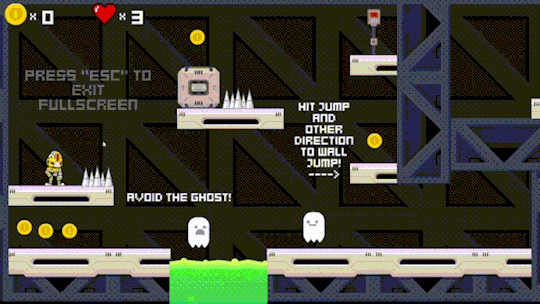
After (Lower Quality due to compressed and resized)
Background Theme Visual
Music and Sound Effects
Interactable Switches Upon Collision
Ghost Animation Changes Upon Distance To Player
Camera Transition
The earlier prototype featured a lengthy single level with the camera fixed on the player. In the updated version, the camera is centered within the level, transitioning to the next "level" when the player moves to the next game area.
Double Jump Controls
Goal of the game:
The goal of the game is to have the player progress throughout the "level" without losing all the health and overcome all the obstacles including a boss fight (time-based).
New Insights:
Throughout the game development, I learned that designing the layout is no simple task. It requires creativity and references from other games or sources. To have each level becoming more challenging as you progress can be brain-wrecking especially taking into consideration that the game remains enjoyable for the players.
Inspiration From Readings:
I've been using the advice from Chapter 1 of 'Fullerton - Game Design Workshop' by having my friends playtest my game whenever I add something new. Their feedback has been really helpful in improving the game. (Fullerton, 2018)
Work-In-Progress Gameplay:
In the next development post, you can expect more complex obstacles and levels of content.
References:
- Fullerton, T. (2018). Game design workshop: A playcentric approach to creating innovative games, fourth edition. CRC Press LLC.
0 notes
Text
GDevelop - Platformer Elevator Pitch (Updated)
Recently, I updated my platform game after receiving valuable feedback from peers. This post here will be an updated Elevator Pitch for my Platformer Game. I have included all the updated information on my updated prototype platform game below.
Name of Game:
RoboRunner
Description of Game:
In my game, players control a robot navigating through levels, dodging obstacles, and enemies, and using parkour moves to advance to the next stage. Players can collect coins scattered around the levels for extra points if they feel competitive. The robot has 3 lives and by losing all 3 lives, you will be forced to restart the game as there will be no checkpoint until the mid-section of the game. The game consists of 5 levels which gets harder each level.
Genre of the Game:
Adventure
Target Audience:
Ages 7+
Mechanics of the Game:
Movement: Arrow keys and Spacebar
Setting of the Game:
The game is set inside a sci-fi factory flooded with acidic liquid. Robot players must escape the factory by avoiding all the obstacles in front of them and reach greater heights by executing parkour jumps and reaching the exit of the factory.
Elevator Pitch:
'In RoboRunner, players embark on a thrilling platforming adventure set within a futuristic factory filled with dangerous acidic substances. As robotic protagonists, players must overcome various obstacles and utilize special wall-jumping abilities to reach new heights and progress through each level. However, navigating through the factory won't be easy, as players will encounter menacing monsters and challenging obstacles blocking their path to freedom. Will players be able to survive and successfully escape from the treacherous factory? It's up to you to guide them to safety!'
Concept Art:

Source: https://www.unrealengine.com/marketplace/en-US/product/sci-fi-factory-01
This will be the planning for my upcoming platformer game which I will be using for the submission of my future assignments. Please do leave a comment in any post to give any feedback as all feedback is valuable to help me better develop my game!
0 notes
Text
Introduction to Adobe Photoshop and Audacity
In this week's IGB101 workshop, we were introduced to editing images using Adobe Photoshop and editing audio files using Audacity. The usage of Audacity software was rather new to me but yet fascinating to learn. Here are some of the points that I've concluded from this week's workshop lessons.
Objective 1: Learning Image Editing with Adobe Photoshop
My first task was to open and edit an image file in Adobe Photoshop. Using the tool of the magic wand and clone stamp tool, I transform a non-transparent image into one with transparency. It was quite the learning curve, but after experimenting with different tools and techniques like the Quick Selection Tool, I managed to achieve the desired effect. There's something oddly satisfying about seeing layers come together to create transparency where there was none before.
Here are some of the results that I've experimented with during my free time and implementing them into Unity 3D:
Coat of Arms

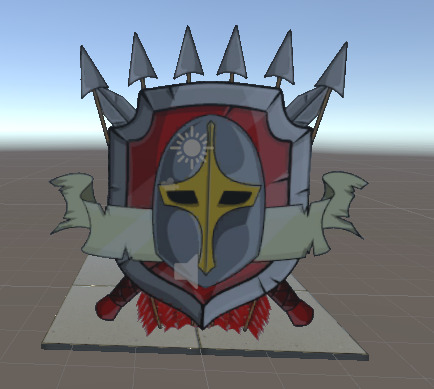

Twitter (Old)


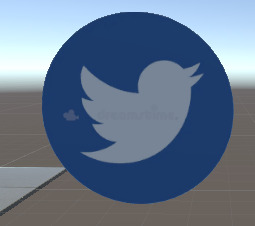
Source: https://www.dreamstime.com/illustration/twitter-logo.html
Chanel


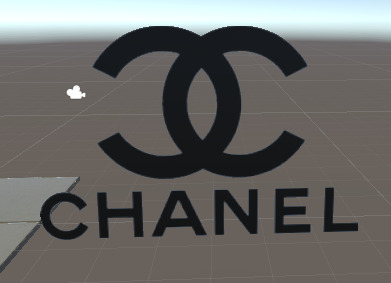
Source: https://www.brandvm.com/post/famous-logos-marketing
Wood Texture (Seamless, 2x2 tiling)


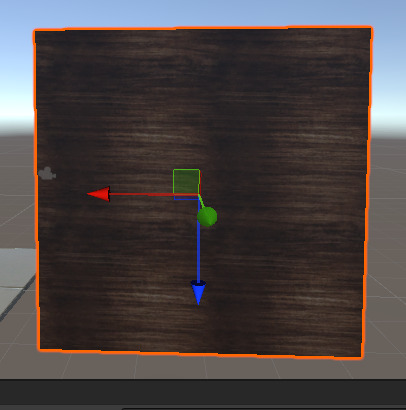
Objective 2: Exploring Audio Editing with Audacity
Then, I tried out audio editing with Audacity. As a beginner, the interface seemed a bit overwhelming at first. But I kept going, opening an audio file and playing around with volume and effects. It was really cool to see how small changes could make a big difference in the sound.
Objective 3: Saving and Optimizing Files for Unity 3D
After fine-tuning my images and audio files, I needed to save and get them ready for Unity 3D. Making sure they had the right formats and were optimized was important for making them work smoothly in my game. It's all about laying a strong foundation to make sure everything runs well in Unity.
Conclusions:
Looking back on what I've done today, I feel really good about improving my file editing skills for making games. Every little thing I did helped me get better, and I know I'll use what I've learned in my next projects. I'm excited to see how these edited files make my game in Unity 3D even better!
0 notes
Text
Gdevelop - Platform Game Development #2
In this week's workshop, we were given the first half of the class to refine our game enough for the second half of the class where we will be refining my game and getting it ready for the first playtest.
Game Scene Overview:
Here's where my game level stands at the moment. It's a basic parkour-style jumping game where you navigate obstacles while either dodging or fighting enemy slimes to earn points. As you go through the level, you can also gather coins for extra points.
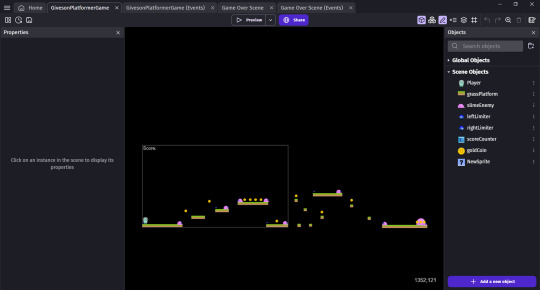
In my latest update, I've made the level more difficult. Now, players must jump over blocks of land to move forward. If they fall through gaps and off the map, they'll reach a "Game Over" scene where they can hit the "R" key to restart the game.

If players fail to stomp on the enemy slime and collide with it instead, the game will switch to the "Game Over" scene, prompting a restart of the entire game.
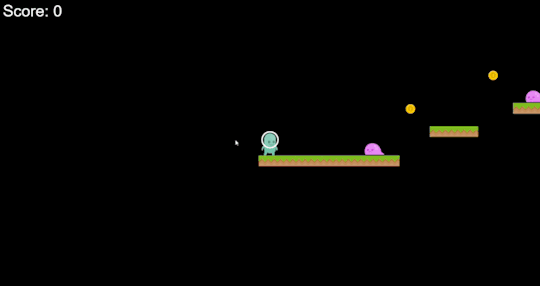
Events:
I've learned an important lesson about organizing events by using folders and comments. It makes it easier for me to find specific events, and it would also benefit my teammates if we were working on a group project together. It's definitely a habit worth adopting.
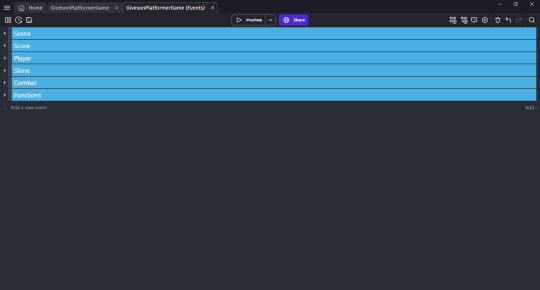
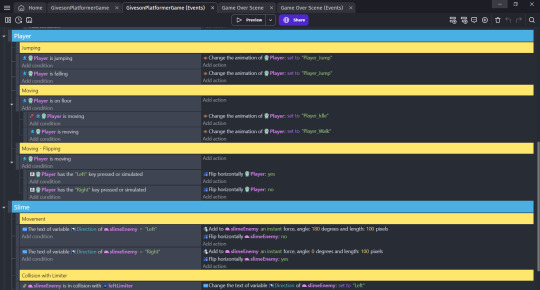
As mentioned above in the 'Game Scene Overview' section, I've added the 'Score Counter' feature to the game, ensuring that the score is constantly visible except when the game transitions to the 'Game Over' scene, at which point the score resets to zero.
The score systems are as follows:
Per Coin collected: 1000
Per Enemy Slime defeated: 1500
Fall off the map: Reset to 0
Defeated by Enemy Slime: Reset to 0
Full Gameplay:

As observed earlier, players must progress through the level by either dodging the enemy slime or defeating it with a stomp, which earns them additional points. Collecting coins also boosts their scores.
The main challenges involve avoiding collisions with the slime by stomping on it instead and navigating the level with parkour-style jumps between platforms, ultimately leading to the final boss encounter at the end of the level.
Feedbacks:
In the latter part of the workshop, we invited classmates to playtest our creations and gathered their feedback. Here are some of the valuable insights I received after the playtest session.
"The game feels unfinished without a clear endpoint where players either stop or fall off the map after completing the level."
"Adding a background would enhance the visual appeal of the game."
"The challenging parkour section of the game seems too brief; consider making it longer and more difficult."
"Including checkpoints or extra lives might make the game easier for players, unless your goal is to make them frustrated by forcing them to restart every time they die."
These valuable insights will be thoroughly incorporated and carefully considered to improve my game further!
0 notes
Text
Weekly Readings - Game Design Workshop - Chapter 8
These are some key points I've summed up after reading Chapter 8 of Game Design Workshop.
Digital Prototyping vs Physical Prototyping
Digital prototyping is making a test version of a game on a computer or other digital device. Unlike physical prototyping, which uses physical materials, digital prototyping lets you try out ideas quickly and easily on a screen. While both methods have their advantages, digital prototyping can be faster and more flexible.
Types of Digital Prototyping
There are different types of digital prototyping, each with its own benefits. For example, wireframing helps designers plan out the layout and structure of a game, while interactive prototypes let them test how the game will work in real time. Digital prototyping allows for more experimentation and iteration, helping designers refine their ideas efficiently.
Camera Viewpoints
Choosing the right camera viewpoint is crucial for creating an immersive gaming experience. Common types of views include first-person, third-person, and top-down perspectives. Each viewpoint offers a unique way for players to interact with the game world, and selecting the appropriate one depends on the type of game and desired player experience.
Effective Interface Design
Effective interface design makes it easy for players to move around the game and find what they need. Designers do this by making menus easy to use, using clear symbols, and having controls that respond well. Interface design should focus on making the game easy to use for everyone, so players can concentrate on playing instead of figuring out how to use it.
Prototyping Tools
Different tools exist for digital prototyping, from specialized software to general design programs. Some popular choices include Unity, Unreal Engine, Adobe XD, and Sketch. These tools come with features like easy-to-use interfaces, libraries of assets, and tools for working together, which help designers turn their ideas into reality more easily.
Conclusion
To sum up, digital game prototyping is a handy and effective way to try out and improve game ideas. Whether it's testing different views, making interfaces better, or trying fresh ideas, digital prototyping lets designers be creative. With the right tools and skills, game makers can make the development process smoother and create games that players everywhere will love.
References:
Fullerton, T. (2018). Game design workshop : A playcentric approach to creating innovative games, fourth edition. CRC Press LLC.
0 notes
Text
Weekly Readings - Game Design Workshop - Chapter 7
After reading Chapter 7 of Game Design Workshop, these are some key points I've summed up.
Prototyping:
Prototyping is the process of creating a basic version of a game to test its mechanics, features, and overall concept. It helps game developers identify strengths, weaknesses, and areas for improvement early in the development process.
Methods of Prototyping:
There are different methods of prototyping, including physical prototypes and Battleship Prototypes. Physical prototypes involve creating tangible models or mock-ups of game components, while Battleship Prototypes focus on simulating gameplay through simple rules and materials.
Prototyping an Original Game Idea:
When prototyping an original game idea, we can start by identifying what's the core mechanics, objectives, and rules. Then, create a basic version of the game using simple materials like paper, cards, or tokens. Once completed, test the prototype with friends or colleagues to gather feedback and refine the concept.
Making the Physical Prototype Better:
To improve the physical prototype, iterate on the design based on feedback and playtesting results. Make adjustments to the rules, components, or layout as needed to enhance gameplay and address any issues identified during testing.
What's Beyond the Physical Prototype:
After refining the physical prototype and getting positive feedback, game makers can go further by making digital prototypes or small parts of the game. These more detailed versions show how the game will look and work on screen, helping to plan out the full game development process.
Conclusions:
To sum up, making prototypes is really important when making games. It helps game creators improve their ideas, try out gameplay, and make sure the final game is what players want. Whether it's a simple model or a fancy computer version, prototyping is the start of making a great game.
References:
Fullerton, T. (2018). Game design workshop : A playcentric approach to creating innovative games, fourth edition. CRC Press LLC.
0 notes